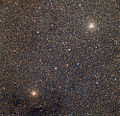NGC 6522
| NGC6522 | |
|---|---|
 | |
| Observation data (J2000epoch) | |
| Class | VI[citation needed] |
| Constellation | Sagittarius |
| Right ascension | 18h03m34.08s[1] |
| Declination | −30° 02′ 02.3″[1] |
| Distance | 25.1kly(7.7kpc)[2] |
| Apparent magnitude(V) | 8.3[3] |
| Apparent dimensions(V) | 9.4′[3] |
| Physical characteristics | |
| Absolute magnitude | −7.67[1] |
| Mass | 5.93×104[4]M☉ |
| Metallicity | = –1.34[2]dex |
| Estimated age | 12.0Gyr[5] |
| Other designations | GCl 82, C 1800-300[6] |
NGC 6522is aglobular clusterof stars in the southernconstellationofSagittarius.It was discovered by German-British astronomerWilliam Herschelon June 24, 1784. The cluster has anapparent visual magnitudeof 8.3 and anangular diameterof9.4′.[3]It is located at a distance of 25.1kly(7.7kpc) from the Sun,[2]and lies in theMilky Way's central bulge,[7]about 2.0 kly (0.6 kpc) from theGalactic Center.[1]The cluster is centered in a region of the sky known asBaade's Window.[8]It is highly impacted byreddeningdue tointerstellar dustand the view is heavily contaminated byfield stars,making it more difficult identify members.[9]
NGC 6522 is possibly the oldest star cluster in theMilky Way,[10]with an age of more than 12 billion years.[11][12]It is acore collapsed clusterwith acore radiusof0.5′and a1.0′half-light radius.[9]The cluster formed four billion years before the Milky Way galactic bar appeared, and may have been confined to the bar for a period of time. At present it trails the bar in its orbit around the core.[13]
This is a low mass globular cluster with an estimated5.93×104times themass of the Sun.Distinctive chemical abundances among the members indicate the cluster has multiple populations of stars, with the younger populations exhibiting pollution from earlier generations.[4]Twentyvariable starshave been identified as members of NGC 6522, consisting of eightRR Lyrae,threetype II Cepheids,and ninelong-period variable stars.[9]Sixpulsarshave been discovered.[14]
Gallery
[edit]-
The globular clustersNGC 6528(lower left) is close to NGC 6522 (upper right)
-
The cluster is located inBaade's Window,a region of night sky that is not clouded by dust from theMilky Way.
References
[edit]- ^abcdDi Criscienzo, M.; et al. (February 2006)."RR Lyrae-based calibration of the Globular Cluster Luminosity Function".Monthly Notices of the Royal Astronomical Society.365(4): 1357–1366.arXiv:astro-ph/0511128.Bibcode:2006MNRAS.365.1357D.doi:10.1111/j.1365-2966.2005.09819.x.S2CID17838243.
- ^abcBoyles, J.; et al. (November 2011). "Young Radio Pulsars in Galactic Globular Clusters".The Astrophysical Journal.742(1): 51.arXiv:1108.4402.Bibcode:2011ApJ...742...51B.doi:10.1088/0004-637X/742/1/51.S2CID118649860.
- ^abcO'Meara, Stephen James (2013).Deep-Sky Companions: Southern Gems.Cambridge University Press. p. 367.ISBN9781107015012.
- ^abFernández-Trincado, J. G.; et al. (July 2019). "H-band discovery of additional second-generation stars in the Galactic bulge globular cluster NGC 6522 as observed by APOGEE and Gaia".Astronomy & Astrophysics.627.id. A178.arXiv:1801.07136.Bibcode:2019A&A...627A.178F.doi:10.1051/0004-6361/201834391.
- ^Koleva, M.; et al. (April 2008)."Spectroscopic ages and metallicities of stellar populations: validation of full spectrum fitting".Monthly Notices of the Royal Astronomical Society.385(4): 1998–2010.arXiv:0801.0871.Bibcode:2008MNRAS.385.1998K.doi:10.1111/j.1365-2966.2008.12908.x.S2CID17571531.
- ^"SIMBAD Astronomical Database".Results for NGC 6522.Retrieved2011-03-13.
- ^Ness, Melissa; et al. (December 2014)."NGC 6522: a typical globular cluster in the Galactic bulge without signatures of rapidly rotating Population III stars".Monthly Notices of the Royal Astronomical Society.445(3): 2994−2998.arXiv:1408.0290.Bibcode:2014MNRAS.445.2994N.doi:10.1093/mnras/stu2144.
- ^"NGC 6522".Students for the Exploration and Development of Space.Retrieved2020-09-23.
- ^abcArellano Ferro, A.; et al. (October 2023). "Variable stars in the field of the Galactic bulge globular cluster NGC 6522".Astrophysics and Space Science.368(10). id. 91.arXiv:2310.16257.Bibcode:2023Ap&SS.368...91A.doi:10.1007/s10509-023-04249-4.
- ^Barbuy, B.; et al. (November 2009). "VLT-FLAMES Analysis of 8 giants in the Bulge Metal-poor Globular Cluster NGC 6522: Oldest Cluster in the Galaxy?".Astronomy and Astrophysics.507(1): 405–415.arXiv:0908.3603.Bibcode:2009A&A...507..405B.doi:10.1051/0004-6361/200912748.
- ^Shiga, David (30 April 2011)."The universe's first stars were whirling dervishes".New Scientist:20.Retrieved2024-09-09.
- ^Chiappini, Cristina; et al. (28 April 2011). "Imprints of fast-rotating massive stars in the Galactic Bulge".Nature.472(7344): 454–457.Bibcode:2011Natur.472..454C.doi:10.1038/nature10000.PMID21525928.
- ^Barbuy, B.; et al. (October 2021). "UVES analysis of red giants in the bulge globular cluster NGC 6522".Astronomy & Astrophysics.654.id. A29.arXiv:2107.08746.Bibcode:2021A&A...654A..29B.doi:10.1051/0004-6361/202140815.
- ^Abbate, F.; et al. (December 2023). "A MeerKAT view of the pulsars in the globular cluster NGC 6522".Astronomy & Astrophysics.680.id. A47.arXiv:2310.03800.Bibcode:2023A&A...680A..47A.doi:10.1051/0004-6361/202347725.
External links
[edit] Media related toNGC 6522at Wikimedia Commons
Media related toNGC 6522at Wikimedia Commons- NGC6522, Galactic Globular Clusters Database page

![{\displaystyle {\begin{smallmatrix}\left[{\ce {Fe}}/{\ce {H}}\right]\end{smallmatrix}}}](https://wikimedia.org/api/rest_v1/media/math/render/svg/4c0821bd80891e071c08e7c7ee8e022baedf522c)

